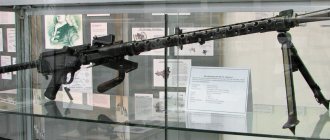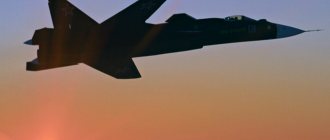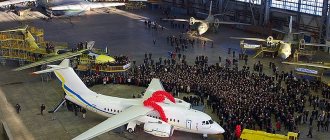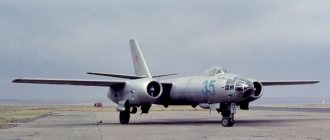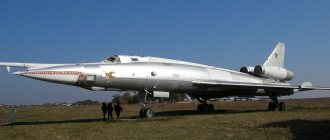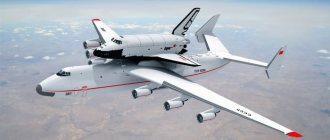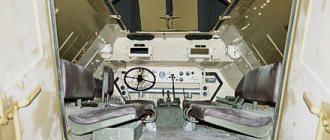Bf. 109F in game
Research and leveling
Researched for Bf.
109E through 15-mm MG-151/15 (M) machine guns, and 20-mm MG-FF/M (M) cannons for 33,500 experience. Recommended sequence for studying modules and installing them:
- Machine guns 13-mm MG-131 (C) (5500), to increase firepower;
- The design of the Bf 109 F-4 (7500), which will slightly increase strength, maneuverability and dive speed;
- Engine DB 601 E (7700), which will give a noticeable increase in speed due to a slight loss of maneuverability;
- Cannons 20 mm MG-151/20 (1941) (M) (5530), to increase firepower.
Combat effectiveness
Almost the entire branch of Messerschmitt fighters are “boom-buzzers”, “Friedrich” is no exception, the tactics are simple - climb, select a target, dive, attack and shoot up. The plane also performs well on aisles. We also take into account that the Bf.109F maneuvers quite well at HIGH, which allows it to evade heavy attacks and approach 6 other high altitudes. It is worth remembering that at altitude Friedrich behaves much more decently than at the ground. It is undesirable to shoot at a distance of over 600 meters, since the most effective distance for our synchronized guns is up to 400 meters. A 20 mm cannon is effective at long distances, but then the damage from it is insignificant.
We can override almost any aircraft at “our” altitude. But it often happens that the initial stage of a battle is won by high-altitude aircraft, and then serious problems arise with the middle and low-altitude echelons.
Let's consider an example: now at level 6 there are 4 representatives of Soviet fighters - La-5, Yak-1M, I-210 and Yak-7, all four aircraft represent a well-armed, highly maneuverable and dangerous enemy.
Yak-1M and Yak-7 - as a rule, we surpass them in altitude, and attacking them from a height does not cause any special problems. The main thing is to monitor your altitude and afterburner. Falling below optimal heights without a good afterburner reserve is strictly not recommended. The Yak-7 with 37mm is also dangerous because it has powerful weapons and will impose dangerous (for us) frontal attacks.
La-5 and I-210 - these aircraft can be found at medium-high altitude levels. The I-210 quickly runs out of steam during vertical maneuvers - which is what you need to use. La-5 is a dangerous adversary. As long as the bench has afterburner (and it cools down quickly enough), the La-5 is capable of performing high-energy maneuvers even at a significant altitude. If possible, try to pull the La-5 “even higher” - with altitude the afterburner efficiency will drop noticeably, there will be nothing to compensate for the energy costs and the La-5 will turn into an easy target. Alternatively, the La-5 can give you altitude and go down. In this case, it is better not to immediately rush after him, but to descend gradually - looking around.
British Spitfires are in many ways similar to the La-5 - they are comparable in level of danger and the same tactics can be used against them.
Advantages:
- good speed performance;
- good altitude;
- good maneuverability at its height.
Flaws:
- average dynamic performance;
- weak weapons.
Equipment, ammunition and equipment
]
Equipment
- Improved reflex sight l
- will add +10% to the aircraft's shooting accuracy. - Improved skin ll
- adds -20% to the probability of receiving critical damage to the wings and tail, and will also add +5% to the strength of the aircraft. - Lightweight design ll
- increases aircraft maneuverability in all axes by 3%.
Ammunition belts
Universal belt - a belt that allows effective shooting and has a low probability of causing critical damage or arson.
Equipment
Standard equipment: Pneumatic restart, Manual fire extinguishers and Trimming handlebars.
Crew
Crew skills
| 1 | 2 | 3 | 4 | 5 |
| Pilot |
Leveling up pilot skills:
“Zorkiy” increases the detection range in the pilot’s sector by 20%.
“Sharpshooter I” reduces the dispersion when firing front-facing weapons by 5%.
“Battle-Scarred” increases the pilot’s survivability and allows him to better control a damaged aircraft. Chance of wounding the pilot -20%, negative effects from damage to the wings and tail -25%.
“Aerobatics” increases maneuverability in all axes by 2%.
“Falcon strike” in a dive when attacking with forward weapons increases the probability of arson and causing critical damage by 50%. The skill is active when the aircraft speed is close to the maximum dive speed and the pitch angle exceeds −45 degrees.
Ace - excellent altitude.
Links
World of Warplanes Resources
- Encyclopedia
- Historical section of the official World of Warplanes website
- Thread on the official forum
Germany
| Fighters | IIArado Ar 67 • IIArado Ar 68 • IIFocke-Wulf Fw 56 Stosser • IIHeinkel He 51 • IIIArado Ar 80 • IIIFocke-Wulf Fw 159 • IVMesserschmitt Bf 109 B • IVHeinkel He 112 • VMesserschmitt Bf 109 E Emil • VMesserschmitt Bf 109 E- 3 • VMesserschmitt Me 209 V4 • VHeinkel He 100 D-1 • VIMesserschmitt Bf 109 F Friedrich • VISupermarine Spitfire V DB 605 • VIIMesserschmitt Bf 109 G Gustav • VIIIMesserschmitt Me 209 A • VIIIHorten Ho 229 • VIIIFocke-Wulf Ta 152 • I XMesserschmitt Me P. 1092 • IXFocke-Wulf Ta 183 Huckebein • XFocke-Wulf Fw 252 • XMesserschmitt Me P.1101 |
| Heavy fighters | IIAGO Ao 192 Kurier • IIIDornier Do 17 Z-7 Kauz • IIIFocke-Wulf Fw 57 • IIIJunkers Ju 52 • IVMesserschmitt Bf 110 B • IVMesserschmitt Bf 110 C-6 • VMesserschmitt Bf 110 E • VMesserschmitt Me 210 • VIMesserschmitt Me 41 0 Hornisse • VIIMesserschmitt Bf 109 Z Zwilling • VIIIBlohm und Voss BV P.203 • VIIIDornier Do 335 A-1 Pfeil • VIIIMesserschmitt Me 262 Schwalbe • IXMesserschmitt Me 262 HG II • XMesserschmitt Me 262 HG III |
| Multi-role fighters | IArado Ar 65 • IVArado Ar 197 • VFocke-Wulf Fw 190 A-1 • VIFocke-Wulf Fw 190 A-5 • VIIFocke-Wulf Fw 190 A-8/R2 • VIIFocke-Wulf Fw 190 D • VIIIMesserschmitt Me 109 TL • VIIIBlohm und Voss P.210 • IXBlohm und Voss P.212.03 • XBlohm und Voss P.215.02 |
| Stormtroopers | IIFieseler Fi 98 • IIHenschel Hs 123 • IIIBlohm und Voss Ha 137 • IIIBlohm und Voss Ha 137 V1 • IVFocke-Wulf Fw 189 C Eule • IVHenschel Hs 129 A • VHenschel Hs 129 B • VJunkers Ju 87 G Stuka • VIJunkers Ju 88 P • VIIMesserschmitt Me 265 • VIIIMesserschmitt Me 329 • IXMesserschmitt Me P.1099 B-2 • XMesserschmitt Me P.1102 B |
| Bombers | IVDornier Do 17 Z • IVHeinkel He 111 H-2 • VJunkers Ju 88 A • VIDornier Do 217 M • VIIJunkers Ju 288 A • VIIIJunkers Ju 288 C • IXJunkers Ju 287 • XJunkers/OKB-1 EF 131 |
Heavy fighters
| USSR | VIITupolev Tu-1 |
| Germany | IIAGO Ao 192 Kurier • IIIDornier Do 17 Z-7 Kauz • IIIFocke-Wulf Fw 57 • IIIJunkers Ju 52 • IVMesserschmitt Bf 110 B • IVMesserschmitt Bf 110 C-6 • VMesserschmitt Bf 110 E • VMesserschmitt Me 210 • VIMesserschmitt Me 41 0 Hornisse • VIIMesserschmitt Bf 109 Z Zwilling • VIIIBlohm und Voss BV P.203 • VIIIDornier Do 335 A-1 Pfeil • VIIIMesserschmitt Me 262 Schwalbe • IXMesserschmitt Me 262 HG II • XMesserschmitt Me 262 HG III |
| Great Britain | IVBristol Blenheim F • VBristol Beaufighter • VIDe Havilland 98 Mosquito • VIIDe Havilland 103 Hornet • VIIIWestland P.1056 • IXGloster P.228 • XGloster Javelin |
| USA | VLockheed P-38F Lightning • VILockheed P-38J Lightning • VIGrumman XP-50 • VIIGrumman F7F Tigercat • VIIFisher XP-75 Eagle • VIIIChance-Vought XF5U Pancake • VIIINorth American P-82B Twin Mustang • VIIILockheed XP-58 Chain Lightning • IXMcDonnell F2H Banshee • XLockheed XF-90 |
| Japan | VKawasaki Ki-45 Toryu • VIKawasaki Ki-102 • VIIRikugun Ki-93 • VIITachikawa Ki-94-I |
| China | VIDe Havilland 98 Mosquito FB 26 |
| France | VSNCASE SE 100 • VIIArsenal VB 10 |
Historical reference
Messerschmitt Bf.109B
- This is the first production fighter from the Bf.109 line. The first Bf.109B-1 rolled off the Augsburg assembly line in February 1937. The oldest fighter squadron, JG.132 “Richthofen,” was chosen first to equip the new fighter, which, after a short retraining course, was sent to Spain in April 1937. This turned out to be a convenient opportunity test the aircraft in real combat conditions and at the same time develop suitable tactics.
Squadrons with the Bf.109B often clashed with large formations of Republican fighters and, despite the small number of Messerschmitt fighters, during the summer-autumn of 1937 they raised the reputation of the new Luftwaffe aircraft to unattainable heights. This experience turned out to be indispensable for future grandiose battles. Several subsequent Luftwaffe aces honed their skills here.
Combat use of Messerschmitt Me-262
To master the Me 262, the EKdo 262 test team was formed in Lechfeld in April 1944, the core of which was Messerschmitt test pilots. At first, the emphasis was on developing tactics that would allow them to intercept high-speed Allied reconnaissance aircraft. The first Mosquito interception (without results) took place on July 25, 1944 - thus, the Me 262 made its first combat mission two days before the British Meteor. In September 1944, EKdo 262 was reorganized into the “Nowotny command” - named after commander Walter Nowotny, and after his death in November 1944 - into III / JG 7. Groups I and II squadrons of JG 7 were formed, but not completely states have not been completed. The main task of the squadron was to intercept American bombers in daylight conditions. By the end of the war, the squadron headquarters and group III/JG 7 had 427 air victories, incl. about 300 four-engine bombers.
In August 1944, the Me 262A-2a fighter-bombers made their combat debut. These aircraft equipped the 1st and then 2nd groups of the KG 51 squadron. Subsequently, the Me 262A entered several more bomber squadrons, reorganized into fighter squadrons - KG(J) 6, KG(J) 27, KG(J) 30, KG(J) 54, KG(J) 55. In February 1945, under the command of A. Galland, the elite fighter unit JV 44 was formed, which began combat work in early April. The only unit that operated Me 262B-1a/U1 night fighters from February 1945 was the “Welter group” (named after commander K. Welter), renamed 10./NJG 11 in April.
Captured Messerschmitt Me 262s were widely studied in the victorious countries. The USSR even considered the possibility of producing a series of such aircraft, but this idea was abandoned because the aircraft did not have any advantages over the MiG-9. Several Me 262s were assembled in Czechoslovakia, both in single-seat (S-92) and double-seat (CS-92) versions.
The Luftwaffe Messerschmitt Me 262 became the first jet fighter to go into battle. Experience with its use showed that the vehicle could be successfully used to intercept enemy bombers, but it had difficulty in maneuverable air combat even against piston-powered fighters. The M e-262 was most vulnerable during takeoff and landing.
History of creation
In 1935, the Kriegsmarine approved a project for the construction of new German aircraft carriers - 2 ships of the Graf Zeppelin
.
In this regard, the Messerschmitt company received the task of developing a special deck version of the Bf.109
, which was developed in 1938 based on
the Bf.109B
.
In the winter of 1939-1940, 2 prototype aircraft ( V17
and
V17A
) were tested on a simulated deck.
These were slightly modified Bf.109Bs
, which revealed a number of shortcomings during takeoff and landing.
On March 26, 1940, tests were carried out on a new prototype developed on the basis of the Bf.109E
. Then the aircraft was tested in Travemünde, and in 1942, together with 2 others, it was used to test the catapult.
Combat use
Initially Bf.109T
it was intended to be used on 2 ships of the
Graf Zeppelin
, as well as
Seydlitz
,
Elbe
and several other aircraft carriers, but not a single ship was completed.
In June 1941, aircraft of the T-2 modification began to be transferred to the I/JG.77 group, based in the Stavanger area. One of the detachments was transferred to Trondheim and renamed JG Drontheim.
24 January 1942 Group I/JG.77, still armed with Bf.109T-2
, changed its name to I/JG.5, and the 3rd detachment was soon transferred to the island of Herdla, where a wooden runway was equipped.
April 10, 1943, surviving Bf.109T-2
were transferred to the JG Helgoland group based on the island of Helgoland.
30 aircraft of the T-2 modification were also in the Reich air fleet until the summer of 1944, later they were transferred to I/JG.5.
How the Allies fought ME-262
In direct confrontation with the Messerschmitt 262, any Allied aircraft was doomed to defeat. Losing to him in speed, maneuver and weapon power, one could not even dream of victory. And yet the Achilles heel was found. Not even alone. The fact is that the Messerschmitt-262 jet fighter turned out to be very vulnerable during takeoff and landing. It was decided to rely on these moments in the confrontation with him.
First of all, all forces were thrown into reconnaissance of the airfields where the German “Swallows” were based. After this, their runway was subjected to merciless bombing. It was mixed with soil almost daily. This continued until the Messerschmitt-262, based at the airfield, was transported to another location.
There are also several known facts of the destruction of “Messers” on takeoff. So, on October 7, 1944, Lieutenant Urban Drew, flying through enemy territory, noticed a pair of jet aircraft taking off from the airfield. Using his advantage in altitude and speed, the pilot boldly attacked his opponents and shot down both, preventing them from gaining speed.
Several ME-262s were also destroyed in air battles. Thus, on November 8, 1944, one of the Luftwaffe aces Walter Nowotny, who had previously shot down 258 enemy aircraft, was shot down during an attack by a formation of American bombers by one of the Mustang P-51 fighters covering him.
Design features of the Messerschmitt Bf-109
- Three-bladed all-metal variable pitch propeller;
- Liquid-cooled engine DB 601 N with a power of 1200 hp. With.;
- Under the engine hood there are two synchronized 7.92 mm MG-17 machine guns;
- The cockpit canopy was made of flat transparent panels; the middle part of the canopy folded down to the starboard side, providing access to the cockpit. The cabin equipment included instruments for monitoring the operation of aircraft systems and the necessary navigation instruments;
- All-metal tail unit: located approximately half the height of the keel and supported by struts, the stabilizer is movable; the angle of its installation could be changed by the pilot in flight;
- The tail wheel was made non-retractable;
- The low-lying trapezoidal wing with metal working skin was distinguished by its light weight - without weapons, the wing console weighed only 130 kg;
- The all-metal fuselage had a minimal cross-sectional area, which was the reason for Soviet pilots to give the Bf-109 the nickname “Thin”. The fuselage had power units for attaching landing gear, which were retracted into the wing during flight;
- The landing gear was attached to the power units of the fuselage and during flight they were retracted into the wing away from the fuselage. Due to this design of the chassis, its track was not wide enough;
History of the Messerschmitt Bf.109 aircraft
The Bf 109 fighter, without any doubt, can be considered a unique symbol of German aviation, its “specialty dish”. The small-sized aircraft with a wasp waist and a characteristic shape of the cockpit glazing, formed by flat transparent panels, with landing gear struts retracting outwards, was universally called by the name of its chief designer “Messerschmitt” and did not indicate any numbers. Second only to the Soviet Il-2 attack aircraft in terms of the number of vehicles produced, the “one hundred and ninth” earned many praises from the pilots who flew it, and no less a number of curses from the flight personnel of Germany’s opponents. For 20 years, the Bf 109 remained in service with the air forces of various countries. And this is a piston engine fighter.
Short biography of “Jagdferband 744 (J744)”
In March 1945, the headquarters of the new formation was located at the Munich-Riem airfield, from where it began intercepting armadas of Allied bombers that were making daylight raids on Germany. In just over a month, this newly-minted elite air unit already had 45 downed allied aircraft. However, this did not last long. On May 3, 1945, it was defeated by the Allies in Salzburg.
Adolf Galland himself also did not refuse the helm of the aircraft. He took part in many operations to intercept Allied bomber raids. On April 25, during one of them, he was shot down by an American cover fighter, the Republic P-47. The pilot was wounded in both knees and was unable to properly land his fighter on the field riddled with craters.
Bf 109B-1
| Model | Bf 109B-1 |
| Crew, man | 1 |
| Year of issue | 1937 |
| Aircraft length, m | 8,70 |
| Wingspan, m | 9,90 |
| Wing area, m2 | 16,35 |
| Takeoff weight | 2197 |
| Power point | Jumo210D |
| Power, hp | 535 |
| Maximum speed, km/h at the ground | 460 |
| Maximum speed, km/h at an altitude of 4000 m | 465 |
| Rate of climb, m/sec | 10,9 |
| Practical ceiling, m | 9000 |
| Flight range, km | 450 |
| Armament: MG-17 7.92 mm machine guns | 2-3 |
Performance characteristics
Scheme Me.163.
The characteristics below correspond to the Me.163 B-1 modification:
Specifications
- Crew:
1 person - Length:
5.69 m - Wingspan:
9.32 m - Height:
2.75 m - Wing area:
19.62 m² - Empty weight:
1,905 kg - Curb weight:
3,950 kg - Maximum take-off weight:
4,110 kg - Engines:
1× jet Walther HWK 109-509A-2 - Thrust:
1× 17 kN
Flight characteristics
- Maximum speed: at sea level 830 km/h, at an altitude of 3000 m 960 km/h
- Landing speed:
220 km/h - Practical range:
200 - Flight duration:
≈ 8 minutes - Service ceiling:
12,000 m - Climbing rates:
3,600 m/min, 4,860 m/min, 10,020 m/min - Wing load:
213 kg/m² - Thrust-to-weight ratio:
0,42
Bf109B-2
| Model | Bf 109B-2 |
| Crew, man | 1 |
| Year of issue | 1937 |
| Aircraft length, m | 8,70 |
| Wingspan, m | 9,90 |
| Wing area, m2 | 16,35 |
| Takeoff weight | 2152 |
| Power point | Jumo210Da |
| Power, hp | 720 |
| Maximum speed, km/h at the ground | 470 |
| Maximum speed, km/h at an altitude of 4000 m | 465 |
| Rate of climb, m/sec | 10,2 |
| Practical ceiling, m | 9000 |
| Flight range, km | 450 |
| Armament: MG-17 7.92 mm machine guns | 2 |
Bf109C-1
| Model | Bf 109C-1 |
| Crew, man | 1 |
| Year of issue | 1938 |
| Aircraft length, m | 8,70 |
| Wingspan, m | 9,90 |
| Wing area, m2 | 16,35 |
| Takeoff weight | 2296 |
| Power point | Jumo210Ga |
| Power, hp | 700 |
| Maximum speed, km/h at the ground | 420 |
| Maximum speed, km/h at an altitude of 4000 m | 470 |
| Rate of climb, m/sec | 9,.52 |
| Practical ceiling, m | 9500 |
| Flight range, km | 450 |
| Armament: MG-17 7.92 mm machine guns | 4 |
Bf109C-2
| Model | Bf 109C-2 |
| Crew, man | 1 |
| Year of issue | 1938 |
| Aircraft length, m | 8,70 |
| Wingspan, m | 9,90 |
| Wing area, m2 | 16,35 |
| Takeoff weight | 2420 |
| Power point | DB600Aa |
| Power, hp | 986 |
| Maximum speed, km/h at the ground | no data |
| Maximum speed, km/h at an altitude of 4000 m | no data |
| Rate of climb, m/sec | no data |
| Practical ceiling, m | 9500 |
| Flight range, km | 450 |
| Armament: MG-17 7.92 mm machine guns | 4 |
By January 1933, when Hitler came to power in Germany, the country's aviation industry employed only about 4,000 workers. At the end of the year there were four times more, but the pace was considered not high enough. In March 1935, Hitler announced the creation of the Luftwaffe and the formation of six air districts. The following principle for numbering deployed formations was introduced: the number of the squadron in the district corresponded to the first digit, the type of aviation (3 for fighters) to the second, and the number of the district to the third.
Thus, the JG132 squadron was the first and only formation of this kind (number 1), belonged to the Luftwaffe fighter aviation (number 3) and was stationed in the Berlin Air District (number 2). In March 1935, this squadron received its own name “Richthofen” in memory of the most successful ace of the First World War. In formation 1, the group was commanded by Major R. von Greim, who was also an ace of the last war with 26 victories, and in the 1920s served as an aviation advisor to Chiang Kai-shek.
The following year, a second fighter squadron was deployed to the Münster Air District. It received the number JG134, and soon its own name “Horst Wessel”, this time in memory of the young Nazi functionary who died in a street clash with the communists in 1930. The third fighter squadron JG 136 was deployed on the basis of an aviation group that previously belonged to the fleet, and the fourth, JG232, was created by borrowing some of the personnel from JG132. All these formations in 1936 were armed with a motley mixture of Ar 64, Ar 65, Ar 68 and He 51 biplane fighters (each squadron group had its own type), as well as FW44 and FW58 training machines
Back – Forward >>
Fighter power plant
From the name of the engine it is clear that this is some modification of the Daimler-Benz DB 605.
Engine Daimler-Benz DB 605
True, I did not find information about the modification called DB-619C anywhere on the network. There are DB 616 power units, there are DB 620, but there seems to be no DB 619. That is, apparently this is an alternative engine. Although, perhaps this is such a little-known motor that information about it simply has not leaked to the network.
But let's return to this power unit. You can’t tell right away what the number of cylinders is, but judging by the size of the power unit, it should be something like the DB 620, that is, 2 DB 605 power units strung on one crankshaft. Thus, it turns out that this engine has 24 cylinders. This thesis is indirectly confirmed by the number of exhaust pipes leading outside (they are very clearly visible in the figure).
Also, apparently, this power unit will be equipped with a double turbocharger, as is done on the DB 628 engine. In this case, the first stage of supercharging will be located in front of the cylinder block.
Daimler-Benz DB 628 engine (both the first and second stages of the turbine are clearly visible)
As for other characteristics of this power unit. Then it will have a normal power of 2870 hp, with afterburner 3450 hp.
With this engine, the aircraft, called Messerschmitt Bf.109K-14, accelerated to a speed of 784 km/h at an altitude of 8,500 km.
Technical features of the aircraft
Among other technical features, it is worth noting that the cooling radiators from the wings, as was previously the case on production Messers, migrated to the engine compartment, just as was done on the FW-190D.
The car received a new large four-bladed propeller. The propeller was made of wood and was the largest of those that could be found on German fighters.
Now, thanks to the installation of turbocharging, the aircraft has an unprecedented service ceiling of 12.5 km.
For flights at such altitudes, the aircraft was equipped with a pressurized cockpit. In addition, a unique flight suit was developed specifically for this fighter, equipped with a built-in toilet. This significantly improved the performance characteristics of the vehicle and made life easier for Luftwaffe pilots.
The wingspan remained the same as on the standard 109s and amounted to 9.97 meters. However, the wing area almost doubled. Because of this technical nuance, the aircraft received excellent maneuverability at low speeds.
Due to the increase in the length of the power unit and engine compartment, the center of gravity of the aircraft shifted forward, so in order to balance it, the length of the fuselage was noticeably increased.
To compensate for the powerful torque generated by the engine, the tail unit of the vehicle was supplemented with a special wooden rib.
The fighter's chassis was also new. It was borrowed, like the radiators from the Focke-Wulf FW-190 fighter. This led to the fact that landing the new Messer became much easier and safer than before.
Armament
As for the vehicle’s armament, there were two modifications of the Bf.109K-14 fighter and the most powerful – the Bf.109K-26.
The Bf.109K-26 was equipped with 2 20 mm cannons. This weapon was located in the forward part of the fuselage, just behind the cockpit, and fired through the plane of the propeller. In the engine compartment there was another cannon, which was the latest version of the 30 mm Krellmettal cannon (no information could be found about this weapon, probably this cannon is an alternative). 4 more, the same 30 mm cannons, were placed in the wings of the car.
As for the Bf.109K-14 version, it was equipped with only two 30 mm cannons in the fuselage, and two large-caliber 13.5 mm machine guns in the wings.
Winners of the Messerschmitt-262 jets: Eastern Front
In addition to the Western European theater of operations, Messerschmitt-262 also appeared on the Eastern Front. True, information about this is quite scanty. Nevertheless, the list of winners of Messerschmitt-262 also includes the names of Soviet aces. Ivan Kozhedub, Lev Sivko, Ivan Kuznetsov, Yakov Okolepov and Alexander Dolgunov have officially registered downed jet Messers. Presumably, two more names should be included in this list: Harry Merkviladze, a pilot of the 152nd Guards Aviation Regiment, and Vladimir Yegorovich from the 402nd Fighter Aviation Regiment.
However, no confirmation of their victories was found in the archives.
Description of design
Wing and tail
Compared to the Emils, the Bf.109T
the wings had a large area and span. In this regard, the slats and ailerons were lengthened, and the flaps also had a larger area.
The consoles could be folded manually relative to the longitudinal hinges located on the outside of the gun mounting units. The wingspan when folded was reduced to 4.1 m.
Chassis
Compared to Bf.109E
Bf.109T
landing gear was significantly strengthened.
Between frames 5 and 6 of the fuselage there was an attachment point for the catapult. The landing hook was attached to frame 7.
Power point
Bf.109T-0
were equipped with DB 601A engines, like all other
Bf.109E-1s
.
Bf.109T-1
and
Bf.109T-2
were equipped with DB 601N engines, which had increased power.
Weapons and equipment
Aircraft Messerschmitt Bf.109T
had exactly the same weapons as “Emily”:
- 2 x 20 mm MG FF cannons with 60 rounds per barrel (in the wings).
- 2 x 7.92 mm MG 17 machine guns with 1000 rounds per barrel (above the engine).
Also modification T-2
had ventral holders for 300-liter tanks, 4 SC 50 bombs or one SC 250 bomb.
Heavy fighter Messerschmitt Bf 110
In the 1930s, the concept of a twin-engine, two-seat heavy fighter, classified by the Luftwaffe as a Zerstorer (destroyer), was very popular in Germany. It was embodied in the Bf 110 aircraft.
The design of the machine began in mid-1934 under the leadership of W. Messerschmitt and W. Rethel. Technologically, the aircraft was very similar to the Bf 109; aerodynamically, it was a monoplane with a double fin and retractable landing gear. The aircraft was equipped with 12-cylinder liquid-cooled engines. The Bf 110V1 prototype first took off on May 12, 1936, the Bf 110V2 on October 24 of the same year, and exactly two months later the Bf 110V3 took off. The pre-production batch included four Bf 110A-0s, delivered from August 1937. These aircraft had Yumo 210Da engines (680 hp), and the armament consisted of five 7.92 mm machine guns - 4 x MG 17 in the nose and 1 MG 15 on the upper mount of the gunner. The fourth vehicle, which entered testing in March 1938, additionally received two 20-mm MG FF cannons (180 rounds of ammunition). In April 1938, serial production of the Bf 110 began. Until February 1945, about 6,000 Bf 110 aircraft of various modifications were built.
MAIN MODIFICATIONS
Bf 110B - Yumo 210Ga engines (730 hp). Until February 1939, 49 aircraft were built, including the Bf 110V7 prototype, three Bf 110B-0 pre-production aircraft and 45 Bf 110B-1 and B-2 production aircraft. Only production vehicles were armed: five 7.92 mm machine guns and two 20 mm cannons. Six aircraft were subsequently converted into dual-control Bf 110B-3 trainers. Bf 110C - DB601A-1 engines (1050 hp), chassis design, engine nacelle outlines changed. The armament corresponded to the Bf 110В-1. In February 1939, the Augsburg plant produced ten pre-production Bf 110C-0s, then until February 1940, 185 Bf 110C-1 aircraft were produced. From September 1939 to July 1940, 539 Bf 110С-2 fighters were produced, which were distinguished by a more modern radio station; the Bf 110С-3 was converted from the Bf 110С-1 by installing MG FF/M cannons with an increased rate of fire (about 20 aircraft were converted). The Bf 110С-4 corresponded to the Bf 110С-2, but with MG FF/M cannons and armored backs for the pilot and radio operator. 155 units were produced, including about 30 in the fighter-bomber version of the Bf 110C-4/B, equipped with two ventral bomb racks for bombs with a caliber of up to 250 kg and DB 601N engines (1250 hp). The reconnaissance version of the Bf 110S-5 was built from June 1940 to January 1941 (100 units). There were no guns on it, and photographic equipment was installed instead. 12 Bf 110С-6, built in May - July 1940 by the same company, instead of 20-mm cannons carried a 30-mm MK 101 cannon in the ventral gondola. Finally, 39 Bf 110С-7 fighter-bombers, produced since July 1940 , were distinguished by elongated landing gear, allowing a 500-kg bomb to be suspended under the fuselage. The total production volume of Bf 110C was 940 vehicles.
Read: 5th generation fighters
Bf 110D - an extended-range variant, adapted to carry additional fuel tanks (1050 l under the fuselage or two 900 l under the wing). The armament corresponded to the Bf 110С-4. The landing gear was strengthened, and an inflatable lifeboat was added to the onboard equipment. From March to September 1940, 83 Bf 110D-0 aircraft were produced, and in July - August of the same year, 33 Bf 110D-1.15 Bf 110D-0 were converted into the fighter-bomber version of the Bf 110D-0/B. The Bf 110D-2 (73 vehicles) was a fighter-bomber with two ventral bomb racks and the ability to suspend two 900-liter tanks under the wing. Next, they built 274 Bf 110D-3s with reinforced bomb racks, allowing them to hang two 1000 kg bombs. Six Bf 110D-4s were reconnaissance aircraft converted from Bf 110D-0s. A total of 463 Bf 110D aircraft were produced.
The Bf 110E is a multi-role variant capable of performing both long-range fighter and fighter-bomber roles. The pre-production batch of Bf 110E-0 was released in August 1940. Such aircraft received an improved sight with expanded capabilities for bombing, and in addition to the ventral bomb racks, they received four more underwing ones for 50-kg bombs. Serial Bf 110E-1 (334 vehicles) were built from August 1940 to August 1941. The Bf 110E-2 (332 aircraft) entered production in October 1940 and differed only slightly. Bf 110E-3 - reconnaissance aircraft without ventral bomb racks. From February to November 1941, 200 aircraft were produced. The total production volume of Bf 110E is 856 vehicles.
Bf 110F - DB 601F engines (1350 hp) were used. Pre-production Bf 110F-0 corresponded to the Bf 110E-0 (except for engines). The Bf 110F-1 had enhanced armor protection for the cockpit. The Bf 110F-2 (190 aircraft produced in December 1941 - November 1942) were distinguished by the absence of ventral bomb racks and an updated composition of on-board equipment. In the latest series, instead of the MG 15 machine gun, the shooter was equipped with a twin MG 81Z. Bf 110F-3 is a reconnaissance aircraft without guns and with an AF. In June - December 1942, 43 aircraft were manufactured. Bf 110F-4 - night fighter, additionally armed with a ventral container with two 20-mm MG 151/20 cannons or two 30-mm MK 108 cannons. Bf 110F-4a - FuG 202 radar installed, built-in MG FF/M cannons replaced by MG 151 /20. From December 1941 to December 1942, 279 Bf 110F-4/F-4a were produced. Bf 110G - DB605A-1 or B-1 engines (1475 hp). Bf 110G-0 - pre-production batch (six units), released in May 1942. The Bf 110G-1 fighter-bomber did not enter production. The Bf 110G-2 long-range fighter was produced by the plant from December 1942 to March 1944 (797 units). Its armament initially corresponded to the Bf 110E, and from February 1943, MG 151/20 guns and a twin MG 81Z gun were installed.
Read: Italian hydrofighter Macchi M.7
The Bf 110G-2/R1 was armed with a 37 mm VK 3.7 cannon (72 rounds of ammunition) in the ventral fairing (the 20 mm cannons were removed). The Bf 110G-2/R3 was equipped with two 30 mm MK 108 cannons instead of four MG 17 machine guns. The Bf 110G-2/R4 was armed with a 37 mm cannon under the fuselage and two 30 mm cannons instead of machine guns. The Bf 110G-3 reconnaissance aircraft was produced in January-September 1943 (172 aircraft). Instead of guns, photographic equipment was installed on it. Bf 110G-4 - night fighter, produced from January 1943 to February 1945 (1850 units). The airframe was basically the same as the Bf 110G-2. The aircraft was equipped with a FuG 212 radar (since the summer of 1943 - FuG 220), as well as direction finders that detected radar radiation from British bombers FuG 221, FuG 227, FuG 350. The Bf 110G-4/R3 version had two MK 108 cannons instead of machine guns, and the one produced from July 1944, the Bf 110G-4/R8 was additionally armed with two 20-mm MG FF cannons in an inclined installation behind the cockpit (there were no defensive weapons in the gunner's cockpit).
HEAVY FIGHTER BF 110: SERVICE AND COMBAT USE
By the beginning of World War II, the Bf 110 was at the stage of introduction into the Luftwaffe - of the 12 planned Zersterer groups, only three were armed with them: I(Z)/LG 1 (Bf 110С), I/ZG 1 and I/ZG 76 ( Bf 110В/С), two more were in the stage of rearmament.
In the Polish campaign and Operation Weserübung, the Bf 110 was used as a long-range fighter. The blitzkrieg in the West in May-June 1940 already involved nine groups of Bf 110s, which were used to escort bombers and fight for air supremacy. At the same time, quite significant losses were suffered - 82 aircraft, almost a quarter of the initial composition of the groups.
Eight groups of “Zersterer” took part in the Battle of Britain, as well as a group of ErprGr 210 fighter-bombers partially armed with Bf 110C/D. By September 7, 1940, four of the eight groups of “destroyers” did not have a single serviceable aircraft left - it became clear that how the Bf 110 escort fighter has exhausted itself.
Nevertheless, they continued to be used as fighter-bombers.
At the beginning of 1941, III/ZG 26 (Bf 110C/D) arrived in Sicily, from where it took part in raids on Malta and then operated in North Africa. I and II/ZG 26 (Bf 110C/E) took part in the war against Yugoslavia and Greece in April 1941, and in May, together with II/ZG 76, in the capture of Crete.
SPEED IMPACT MACHINE
By the time of the attack on the Soviet Union, the Bf 110 was considered primarily not as an escort fighter, but as a high-speed attack vehicle. Four groups of such aircraft took part in Operation Barbarossa - I and II/SKG 210, as well as I and II/2G 26. They carried out bombing attacks on airfields, railway junctions, columns and concentrations of troops, operating in the zone of Army Group Center. . At the end of August - September 1941, groups I and II/ZG 26 operated in the Leningrad area, and subsequently again in the zone of Army Group Center.
Read: Su-7B - supersonic combat aircraft
In the spring of 1942, only two groups of Zersterers -1 and II/ZG 1 remained on the Eastern Front, which, in addition to the Bf 110E, were armed with the new Bf 110F-2. In May - August 1942, I and II/ZG 2 also fought here, soon assigned to the Reich to man air defense units. In 1942, the “destroyers” fought mainly on the southern sector of the front - over Ukraine, Don and Kuban, as well as Stalingrad. They were used almost exclusively as percussion instruments. The last Bf 110 group to operate on the Eastern Front was l/ZG 1, which took part in the Battle of Kursk in the summer of 1943 and was then withdrawn to Germany.
NIGHT FIGHTER
The fiasco of the “Zersterer” concept, which became obvious already during the Battle of Britain, by no means put an end to the career of the Bf 110. Although these aircraft continued to be used at the front as attack vehicles, a much larger number of “hundreds” served to protect the airspace of the Reich in night fighter squadrons. At first, these formations received ordinary Zersterer Bf 110 modifications C, D and E, but in the spring of 1942, full-scale deliveries of radar-equipped Bf 110F-4 aircraft began. From 1942 to 1944, the Bf 110 was the main armament of seven night fighter squadrons; In addition, ordinary Zersterer groups operating during the day were also involved in air defense. The Bf 110 was much better suited for radar installations than the more modern Me 210/410, although its speed and flight endurance were considered insufficient. Generated by the Douay Doctrine, the Bf 110 was used for a very short time in the capacity in which it was intended - as a long-range escort and air superiority fighter. Already in the summer of 1940 it became clear that the machine was not suitable for these purposes. However, the Bf 110 design was suitable for modification, and the vehicle was adapted to serve as a high-speed bomber, reconnaissance aircraft and, finally, a night fighter. After the Polish campaign, the Bf 110 proved indispensable in the capture of Norway, took part in the Blitzkrieg in the West and the Battle of Britain. On the Eastern Front, shock functions became the main ones for the “one hundred and tenth”. Finally equipped with radar, it became the main type of night fighter in the Reich defense forces. Despite a number of “inherent” shortcomings (primarily the short flight range), the Bf 110 remained in production until February 1945, and was actually used in battle until the last days of the war.
You might be interested:
- Pe-3 fighter
- Pe-8 bomber
- German fighter Messerschmitt Me 209/I
- Fighter Heinkel He 219 "Uhu" - "owl" of the Luftwaffe
- German fighter Dornier Do 335 Pfeil
- Vickers Wellington medium bomber
Subscribe to
our channel in Yandex.Zen

